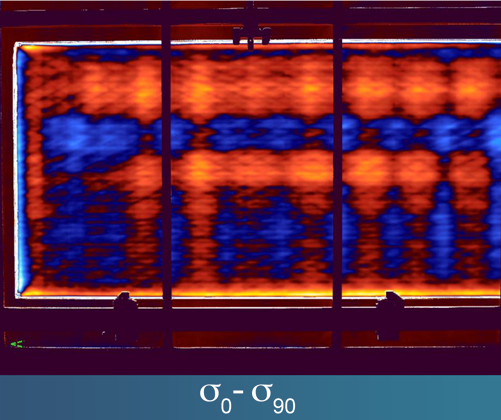Tempered Architectural Glass
Edge stress image of 9mm tempered architectural glass. The image above was acquired with the GFP™1600 FPI (Flat Panel Illuminator).
Applications Overview » Architectural Glass
Applications Overview » Architectural Glass
Stress Photonics provides a wide range of inspection tools to inspect and measure such stress in architectural glass as:

We offer three options for measuring architectural glass edge stress. One is the GFP2600 that, when set at the edge of a test table or conveyor, can be configured as a very effective edge stress measurement tool. This versatile edge tool can move down the edge of the glass. Alternatively, the glass can be inspected as it moves through the edge stress measurement system.
The second in the list of options for edge stress measurement is the popular EdgeMaster 2—a viable edge stress measurement tool for flat glass. Because architectural glass typically has no frit, the EdgeMaster 2 provides its own reflective surface behind the glass.
The third option that we offer for edge stress measurement is the GFP1600, primarily utilized as an area stress measurement tool, can also use close-up lenses to determine edge stress—specifically the GFP1600 FPI (Flat Panel Illuminator) or a GFP1600 in conjunction with a Flex Illuminator.
The GFP1600 FPI (Flat Panel Illuminator) is the most commonly used system for measuring area stress/temper patterns.
Another popular area stress/temper pattern measurement system is sold in cooperation with LiteSentry: the Osprey Complete™. The Osprey Complete is based on a line of GFP2600 real-time stress measurement systems. A conveyor-wide “strip” of stress is measured as the glass advances down the conveyor. The strip images are then “stitched” together using special software to form complete stress maps.
The impact of thermal loads such as sun or deep freezing temperatures can be determined with the GFP1600 using the REFLECT Illuminator. Even IGUs can be tested if the inside surface of the glass is painted silver to reflect light. The individual pane of glass can be isolated, and the effects of sealant stiffness can be assessed.
Iridescence occurs when unbalanced residual temper stress selectively reflects naturally polarized light such as blue sky or water reflections. The GFP1600 FPI is the instrument of choice for measuring iridescence. Stress Photonics’ GFP™ (Grey-Field Polariscope) technology will measure the anisotropy and the directions of the incident planes that will excite maximum iridescence.
Need help? Email our expert support team via our contact form or call us at +1 (608) 224-1230
Need help? Email our support
team via our contact form
or call us at +1 (608) 224-1230

Glass Photonics was founded by Stress Photonics to better serve the glass industry.
All products are manufactured by Stress Photonics Inc.